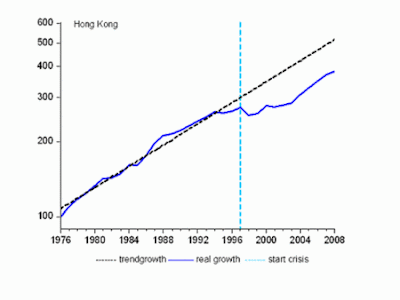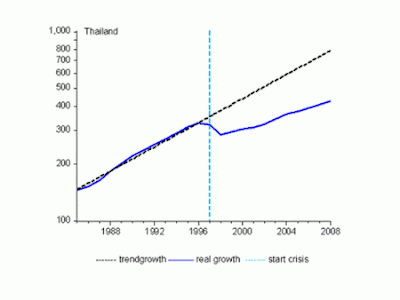What are the long-term consequences of prolonged periods of high unemployment and slower economic growth? As economic growth returns back to normal levels, does the labour market recover to its pre-crisis normal? Does capital investment by businesses and investments in research and development regain its pre-crisis trends? In simple terms, how much time does it take for the actual output to close the gap with the potential output? Or is there a danger that a permanent output gap will get crystallized?
In a recent paper, Brad DeLong and Lawrence Summers highlighted the important role of hysteresis effects. They claim that a long enough recession can erode the capability of both human and physical capital, and recovery cannot be taken for granted. There is enough evidence that long-term unemployment has scarring effects on those affected. I have blogged earlier about the harmful effects of long-term unemployment.
Greg Ip has written in Free Exchange about the possibility that America's potential output itself may have come down during the Great Recession. He points to the reduction in labour force participation rate, which appears to have stabilized at a lower level, and the lower (than trend rate) productivity rate in recent years. He argues that the actual output has been depressed for so long that hysteresis has set in and dragged the potential output down with it.
Mark Thoma has a striking illustration of the long-term consequences of deep recessions by pointing to the example of East Asian economies after their recessions following the 1997 currency devaluation crisis. All the major East Asian economies - South Korea, Malaysia, Indonesia, Hong Kong and Thailand - continue to remain considerably behind their long-term trend growth rates, even a decade after that crisis.





Much the same fate has befallen Japan since its early nineties asset prices crash. The economy fell-off the trend line for a prolonged period. Though there were signs of a recovery in the second half of last decade, the sub-prime crisis appears to have snuffed that out.

If hysteresis does indeed drag and keep down growth, then that alone would be a strong enough reason for governments to indulge in aggressive monetary and fiscal accommodation to boost aggregate demand and ensure that all idling resources are optimally employed.
In a recent paper, Brad DeLong and Lawrence Summers highlighted the important role of hysteresis effects. They claim that a long enough recession can erode the capability of both human and physical capital, and recovery cannot be taken for granted. There is enough evidence that long-term unemployment has scarring effects on those affected. I have blogged earlier about the harmful effects of long-term unemployment.
Greg Ip has written in Free Exchange about the possibility that America's potential output itself may have come down during the Great Recession. He points to the reduction in labour force participation rate, which appears to have stabilized at a lower level, and the lower (than trend rate) productivity rate in recent years. He argues that the actual output has been depressed for so long that hysteresis has set in and dragged the potential output down with it.
Mark Thoma has a striking illustration of the long-term consequences of deep recessions by pointing to the example of East Asian economies after their recessions following the 1997 currency devaluation crisis. All the major East Asian economies - South Korea, Malaysia, Indonesia, Hong Kong and Thailand - continue to remain considerably behind their long-term trend growth rates, even a decade after that crisis.





Much the same fate has befallen Japan since its early nineties asset prices crash. The economy fell-off the trend line for a prolonged period. Though there were signs of a recovery in the second half of last decade, the sub-prime crisis appears to have snuffed that out.

If hysteresis does indeed drag and keep down growth, then that alone would be a strong enough reason for governments to indulge in aggressive monetary and fiscal accommodation to boost aggregate demand and ensure that all idling resources are optimally employed.
No comments:
Post a Comment